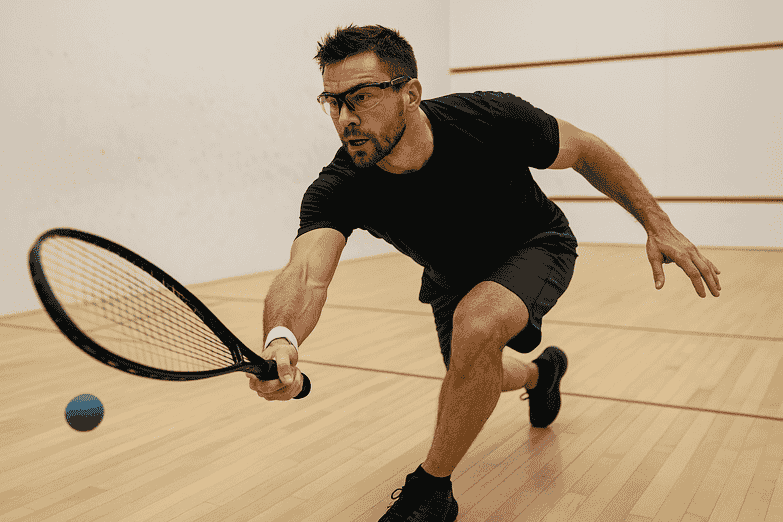Get The Mental Edge in Racquetball – with Mind Training
By Craig Townsend
Clinical Hypnotherapist, Mental Trainer & Founder of
NeuroFrequency Programming™
A groundbreaking multi-layered method that blends advanced mind techniques with various brainwave frequencies to unlock deeper potential, dissolve limiting patterns, and rewire your subconscious for lasting transformation. Learn more about NeuroFrequency Programming™ and the Multi-Track Transformation System™ →
Do you play better racquetball in practice than in competition?
Affected by doubt, nerves, intimidation, or looking to take your game to the next level?

Mental training, when added to your on-court practice, gives you a decisive edge over competitors.
When you are playing at your highest level, your strokes and movement flow instinctively on auto-pilot - all controlled by your powerful
subconscious
Your subconscious is the powerhouse of peak performance, controlling all bodily movement, storing your training experience and muscle memory, and guiding your body with effortless efficiency and precision. Estimated to be 275,000 times more powerful than the conscious mind [University of Pennsylvania]
mind.
When two players have similar physical skills, it’s the mind - the belief, focus, and resilience - that separates the winner.
Champions tend to access more of their subconscious power than intermediate players, often using mental training techniques like visualization (which we’ll explore shortly).
Players who train both their mind and body consistently improve faster than those who only rely on physical practice.
Benefits of Mental Training
Mind training creates a mindset of success. It builds an unshakable shield of confidence, expectation, and belief that you can perform at your peak - no matter who your opponent is.
When applied correctly, mental training delivers consistent performance improvements for players at all levels.
Some of the key areas it improves include:

Advantages / Uses
- Increased belief and inner confidence in your ability
- Overcoming nerves, intimidation, and self-sabotage
- Better consistency and concentration in practice and competition
- Improved shot selection during high-pressure rallies
- Breaking negative self-talk and performance slumps
- Stronger mental toughness and resilience
- Enhanced visualization skills for shot and strategy rehearsal
- Greater motivation and goal-setting
Mental training builds the confidence to handle pressure and intimidation, improving both stroking ability and competitive results.
Mind mastery is no different from mastering physical skills - you must work out at the inner gym. Developing unbreakable belief, focus under pressure, and the ability to pre-program success offers endless rewards.
The Power of Visualization
Visualization is one of the most powerful mind-training tools used by elite athletes. It involves realistically picturing your ideal performance to program success into your subconscious.
Examples include:
- Mentally rehearsing all strokes - from kill shots to cross-court passes
- Serving with accuracy using drive serves, Z serves, and lob serves
- Strategically moving your opponent around the court
- Visualizing perfect footwork and fluid court movement
When combined with proper relaxation, visualization can unlock a whole new level of performance.
Overcoming Self-Sabotage
Many players face recurring patterns of self-sabotage caused by deep-seated doubts or anxiety. Mental training eliminates this by reprogramming self-belief and clearing inner hesitation.
The Zone
Mental training also helps you access ‘the Zone The Zone is the peak performance state where your body runs directly from the subconscious. Movements flow naturally, distractions fade, and effort feels effortless as you perform at your absolute best. ,’ the ultimate peak-performance state. In this state, your subconscious takes full control, creating effortless strokes, seamless movement, and unbeatable confidence on the court.
This is when everything flows - your timing, strategies, and reactions feel instinctive, smooth, and unstoppable.
The more you train your mind, the stronger your game becomes - both mentally and physically.
Implementing & Mastering These Techniques at Home
 |
|---|
For generations, athletes have relied on powerful techniques like visualization to gain a competitive edge. Now, with advancements in modern technology, these techniques have become even more sophisticated
I will outline some examples for you shortly, which you can practice at home (as effective do-it-yourself programs are what most people are asking for).
I have outlined the various options below to cater to different levels, so you can choose the best path you'd like to explore..
Training Options - For Different Standards, Levels & Skill Sets
Depending upon your level of experience and expertise, there are two distinct approaches to mental preparation:
1. Accelerated Techniques (audio MP3 subconscious training for faster results) or
2. Manual Methods (free self-guided options listed below).

|
|---|
Accelerated Techniques
Intermediate & Advanced Competitors
Designed to achieve results in as little as 4–6 weeks that might otherwise take up to 12 months with traditional training.
If you prefer to skip the long hard manual work of mental training (which I also outline further below), then the easiest step to accelerate your progress is to get the fast-track audio program below – developed from decades of coaching elite athletes, combining neuroscience with hypnotic techniques. Just $29.
These audios embed everything straight into your subconscious, so no manual repetition is needed.
Fast-Tracking Your Results
Mind Training for Racquetball
by Craig Townsend (Dip. Clin. Hyp)
MP3 Download $29.95
Incl. Bonus: Sleep Subliminal (value $30)
1 Year Unconditional Warranty
Or the ultimate solution for the most serious competitors...
Personalized Mind Training
Mind Programs for Advanced & Elite Competitors
The next-level of training is to check out NeuroFrequency Programming - a system of customized
theta-level
Theta brainwaves (4–8Hz): Unlocks heightened creativity, mental clarity, and subconscious alignment - ideal for accelerated learning, focus, and peak performance.
mental training recordings, personalized to your exact needs, training, schedule, mindset, and competition challenges - to deal with confidence, focus, resilience, and overcoming nerves or lack of belief.
This shifts your mind quickly into a higher gear - integrating your training deeply at the software level, to create strong and lasting improvements in performance, mindset, and results. More details below.
Manual Methods
Developing Competitors
Of course, if you are just starting out, time is not an issue, and quick turnaround on results is not urgent - you can always begin by practicing the various mental exercises manually - and you can always progress to the next level later on - which will combine these and other techniques simultaneously, to further accelerate your results. (see below).
For those who can dedicate time to regular to regular practice and reinforcement, I have provided a selection of options and info below you can work through, and explore further.
(if you have further questions - simply drop me an email)
 |
|---|
1. Embedding Positive Core Beliefs
This exercise, called a contemplation, embeds powerful new core beliefs within your subconscious, as these enormously influence performance.
Your beliefs - weak or strong - ultimately determine your results - your susceptibiity to unconscious self sabotage, and how far your potential can develop. They are the dominating force - more powerful than motivation, talent, ability, fitness, power, etc.
These are your 5 Core Beliefs list to instill, below. Focus on each point in the list for 30 seconds daily, thinking of positive thoughts related to the topic and reasons why it's true for you.
Do this until the reasons are true for you.
1. I have the agility, footwork, reflexes and anticipation to be a formidable opponent.
2. I possess the variety and wide range of shots, serves, drives, passes and kills, to keep opponents off balance and dictate play.
3. I quickly recognize patterns of play and adapt accordingly, anticipating opponents' shots, and executing effective shot selections.
4. I have the resilience and mindset to handle the mental challenges, pressure situations, momentum swings and fatigue - and still succeed.
5. I remain calm, focused and in the present moment at all times during each game.
 |
|---|
2. Visualization Exercises
Needless to say, the initial and primary visualization should be of yourself competing at your absolute peak of your performance - with as much, or as little, detail as you wish - while imagining experiencing great confidence and inner power while you are performing - along with the joy of success afterwards.
Do this each day, while in a relaxed state (directly before or after sleep are excellent times), and ensuring you use all your senses - ie. ensure the images are vivid, realistic, present-tense, positive, and without any external distractions.
If, like most others, you find your motivation to manually do these exercises eventually peters out altogether - just make sure you do this one exercise.
While the results wont be as quick as using the audio recordings, slowly but surely this will bring about improvements, so be patient. As you progress in your development, consider integrating the following aspects to enhance your mind's capacity to visualize flawless performance.
As there are literally hundreds of different ways you can use imagery for various different purposes, I have included some options you can experiment with later on.
But for now, keep to the basics, and make sure you practice regularly.
*
Mental Imagery Examples.....
- Hitting with precision - enhances your accuracy and control during matches.
- Anticipating your opponent's shots - elevates your reaction time and help you stay ahead of the game.
- Moving quickly and fluidly on the court -boosts your footwork and agility during matches.
- Hitting different types of shots - expands your versatility and adaptability during matches.
- Different court conditions - broadens your mental flexibility and helps adjust to new environments.
3. Affirmations for Performance
You can also manually recite a mantra over and over again silently in your mind, which is a manual auditory method which can be targeted towards specific uses - plus work great to drown out nagging negative thoughts during performance.
Note: Ensure you use a great deal more repetition to create the necessary reinforcement, seeing these will be recited at the conscious, rather than subconscious, level. A manual way to get around this can be reciting mantras in the shower, which relaxes the mind and body.
Some examples below.. ensure the statements are positive, present-tense, and with no hidden or reverse negatives.
"I have great hand-eye coordination" - You are able to track the ball well and anticipate its movements, which helps you hit it more accurately and consistently.
"I am quick on my feet" - You are agile and able to move around the court quickly, which allows you to get to the ball faster and return shots more effectively.
"I am a strategic thinker" - You are able to analyze your opponent's strengths and weaknesses, and adjust your game plan accordingly to gain an advantage.
"I am mentally tough" - You are able to stay focused and maintain your confidence even when facing tough opponents or challenging situations.
"I am a skilled server" - You are able to serve the ball with accuracy and consistency, which sets the tone for the rest of the game.

Listen...
* Audio – “The Power of Visualization & Belief”
Craig Townsend explains how these transform performance.
Click the “Play” symbol to start the audio.
